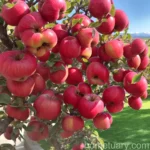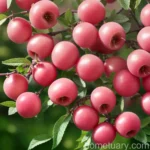Flowering Crabapple (Malus ‘Ralph Shay’) – A Plant Scientist’s Guide
In the world of ornamental trees, the flowering crabapple (Malus ‘Ralph Shay’) stands out as a charming and versatile species. With its vibrant blossoms and colorful fruits, this tree has earned a special place in gardens and landscapes. As a plant scientist, I am excited to delve into the nuances of this beautiful plant, exploring its cultural aspects, uses, care requirements, and unique characteristics.
What is Plant: Flowering Crabapple (Malus ‘Ralph Shay’)?
The flowering crabapple, scientifically known as Malus ‘Ralph Shay,’ belongs to the Malus genus within the Rosaceae family. This species is renowned for its ornamental value, characterized by showy spring blooms and decorative fruits. As a fruit-bearing tree, it adds aesthetic appeal as well as potential wildlife benefits to its surroundings. The ‘Ralph Shay’ cultivar specifically is celebrated for its remarkable features, making it a popular choice among gardeners and landscapers.
Key Takeaways – Flowering Crabapple (Malus ‘Ralph Shay’)
Before diving deeper into the various aspects of the flowering crabapple, let’s highlight some key takeaways about this captivating plant:
- Malus ‘Ralph Shay’: A cultivar within the Malus genus, recognized for its ornamental attributes and fruit-bearing nature.
- Versatile Uses: Suitable for gardens, landscapes, and smaller spaces; appreciated for its blooming and fruiting features.
- Cultural Requirements: Needs adequate water, sunlight, fertilizer, and well-draining soil for healthy growth.
- Pruning and Propagation: Regular maintenance, including pruning and potential propagation for expanding the plant population.
- Common Diseases and Pests: Vulnerable to certain diseases and pests, requiring proactive management and care.
- Botanist’s Tips: Insights and recommendations from plant experts to optimize the growth and development of flowering crabapples.
- Fascinating Facts: Unveiling intriguing and lesser-known facts about this delightful species.
With these key points in mind, let’s embark on a comprehensive journey through the world of flowering crabapples, with a specific focus on the ‘Ralph Shay’ cultivar.
Culture
Water
Proper hydration is essential for the well-being of flowering crabapple trees. While they are relatively adaptable to different moisture levels, consistent watering is crucial, especially during the initial stages of growth and establishment. Adequate moisture helps in promoting healthy foliage, blossoms, and fruit set.
- Watering Guidelines:
- Newly planted trees: Water deeply once or twice a week during dry periods.
- Established trees: Monitor soil moisture and ensure sufficient watering, especially in the absence of rainfall.
Sunlight
Flowering crabapples thrive in full sun to partial shade conditions. Ample sunlight is instrumental in stimulating robust flowering and fruit production. When selecting a planting location, it is important to consider the availability of sunlight throughout the day to provide an optimal environment for the tree.
- Sunlight Requirements:
- Full Sun: Ideally 6-8 hours of direct sunlight per day.
- Partial Shade: Tolerant of moderate shade, especially in hotter regions.
Fertilizer
Appropriate fertilization supports the overall health and vigor of flowering crabapple trees. A balanced fertilizer, specifically formulated for trees and shrubs, can be applied to enrich the soil and provide essential nutrients. It is advisable to conduct soil tests to determine the specific fertilizer needs based on the existing nutrient levels.
- Fertilization Practices:
- Spring Application: Apply a slow-release, balanced fertilizer in early spring to fuel new growth.
- Avoid Excessive Nitrogen: Moderate nitrogen levels to prevent excessive vegetative growth at the expense of flowering.
Soil
The soil quality directly impacts the growth and development of flowering crabapple trees. Well-draining, loamy soil with a slightly acidic to neutral pH range is well-suited for these trees. Adequate soil preparation before planting and periodic soil amendments contribute to a conducive root environment.
- Soil Recommendations:
- Soil Composition: Loamy, well-draining soil.
- pH Range: Slightly acidic to neutral (pH 6.0-7.0).
- Organic Matter: Incorporate organic compost or mulch to enhance soil structure and fertility.
Uses
Ornamental Beauty
The flowering crabapple, especially the ‘Ralph Shay’ cultivar, is primarily valued for its ornamental allure. The tree’s blooming phase, featuring abundant and colorful flowers, adds a picturesque charm to gardens and landscapes. Its ability to attract pollinators further underscores its ornamental significance.
- Garden and Landscape Applications:
- Accent Tree: Stunning centerpiece in garden beds and open landscapes.
- Visual Interest: Adds vibrant color and texture during the flowering season.
- Pollinator Attraction: Beneficial for attracting bees and other pollinating insects.
Fruit Production
In addition to its visual appeal, the flowering crabapple serves as a modest fruit-bearing tree. While the fruits are typically smaller than traditional apple varieties, they contribute to the tree’s overall decorative appeal. The fruits can also serve as a food source for wildlife, including birds and small mammals.
- Wildlife Benefits:
- Bird Attraction: Fruits serve as a food source, attracting avian species to the garden or landscape.
- Aesthetic Value: Colorful fruits enhance the visual appeal of the tree, especially in the fall season.
Pruning
Proper pruning practices are essential for maintaining the health, shape, and flowering capacity of flowering crabapple trees. Routine pruning helps in controlling the tree’s size, promoting air circulation, and managing potential disease issues. It also contributes to shaping the tree according to desired aesthetic preferences.
- Pruning Guidelines:
- Season: Prune in late winter or early spring before the onset of new growth.
- Removal of Diseased Wood: Eliminate any diseased, damaged, or dead branches to promote overall tree health.
- Thinning and Shaping: Thin out crowded branches and shape the tree to enhance its structure and appearance.
Propagation
The propagation of flowering crabapples, including the ‘Ralph Shay’ cultivar, allows for the expansion of their presence in various settings. Both sexual and asexual propagation methods can be employed, each with its own set of techniques suited to the specific characteristics of this species.
- Propagation Techniques:
- Seed Propagation: Growing new plants from seeds, though the resulting plants may exhibit genetic variability.
- Grafting: Utilizing grafting techniques to propagate and preserve the specific traits of the ‘Ralph Shay’ cultivar.
Container Popularity
For gardeners with limited space or those looking to enhance their outdoor living areas, flowering crabapples, including the ‘Ralph Shay’ cultivar, are increasingly being grown in containers. The adaptability of these plants to container cultivation opens up new possibilities for incorporating them into diverse environments.
- Advantages of Container Growth:
- Space Efficiency: Suitable for small gardens, patios, and urban settings.
- Versatility: Allows for convenient placement and mobility, catering to varying design preferences.
Container Care
When growing flowering crabapples in containers, attention to specific care requirements is pivotal for ensuring their well-being and sustained growth. Adequate watering, soil management, and occasional maintenance are essential components of container cultivation.
- Care Practices:
- Proper Drainage: Ensure well-draining containers and proper drainage to prevent waterlogged soil.
- Watering Management: Monitor soil moisture and adjust watering frequency based on environmental conditions.
- Soil Quality: Utilize high-quality potting mix with appropriate fertility and structure.
Common Diseases
Certain diseases can affect flowering crabapple trees, potentially impacting their overall health and ornamental appeal. Familiarizing oneself with the common diseases and their associated symptoms is crucial for early detection and effective management.
Disease Diagnosis
Understanding the characteristic signs of prevalent diseases in flowering crabapples, such as apple scab, powdery mildew, and fire blight, enables prompt diagnosis and intervention. Timely recognition and treatment are vital for mitigating the impact of diseases and preserving the tree’s vitality.
- Common Diseases:
- Apple Scab: Identification of velvety, olive-green lesions on leaves and fruits.
- Powdery Mildew: Detection of powdery white fungal growth on leaves and shoots.
- Fire Blight: Recognition of wilting, blackening, and cankers on branches, often accompanied by a characteristic shepherd’s crook shape.
Common Pests
In addition to diseases, certain pests can pose challenges to the well-being of flowering crabapple trees. Pests such as aphids, caterpillars, and scale insects are known to affect these trees, necessitating vigilant monitoring and effective pest control measures.
Pest Management
Implementing integrated pest management (IPM) practices, including cultural, biological, and, if necessary, chemical control methods, aids in managing pest infestations without causing harm to beneficial organisms or the environment.
- Pest Control Measures:
- Cultural Practices: Encourage natural predators and beneficial insects, maintaining a balanced ecosystem.
- Biological Control: Utilize natural enemies and biological control agents to suppress pest populations.
- Selective Treatment: If needed, employ targeted and least-toxic control options to address severe pest outbreaks.
Botanist’s Tips
As a plant scientist, I impart the following tips for maximizing the success and visual impact of flowering crabapple trees, particularly the ‘Ralph Shay’ cultivar:
- Selecting the Planting Site: Choose a well-drained location with ample sunlight to optimize the tree’s growth and flowering potential.
- Regular Monitoring: Periodically inspect the tree for signs of diseases, pests, and overall health to address any issues proactively.
- Pruning Best Practices: Adhere to proper pruning techniques, focusing on disease prevention, structural enhancement, and aesthetic refinement.
- Nutrient Management: Implement a balanced fertilization regimen based on soil test results to provide adequate nutrition without overstimulating vegetative growth.
Applying these insights and recommendations contributes to the long-term vitality and beauty of flowering crabapples in diverse settings.
Fun Facts
Uncovering the fascinating aspects and lesser-known details about the flowering crabapple, particularly the ‘Ralph Shay’ cultivar, adds depth to the appreciation of this captivating species:
- Vibrant Fruit Palette: Apart from the pink flowers, the ‘Ralph Shay’ cultivar produces small red crabapples, enhancing its visual appeal in the autumn landscape.
- Wildlife Interaction: The fruits of flowering crabapples attract a range of wildlife, including birds and small mammals, contributing to ecological diversity.
- Ornamental Significance: Across various cultures, the crabapple tree symbolizes beauty, love, and transformation, further enriching its symbolic importance.
Links to External Resources
To further expand your knowledge and understanding of flowering crabapples, including the ‘Ralph Shay’ cultivar, I recommend exploring the following reputable resources:
- American Society of Landscape Architects
- The Morton Arboretum
- Royal Horticultural Society
- University Extension Services
These resources offer valuable insights, research findings, and practical guidance on horticulture, landscaping, and ornamental plant care, enriching your exploration of the diverse facets of flowering crabapples and related subjects.
In conclusion, the flowering crabapple (Malus ‘Ralph Shay’) exemplifies the fusion of ornamental beauty, fruit-bearing capacity, and ecological significance. Its cultural requirements, uses, care practices, and unique characteristics contribute to its remarkable appeal in gardens, landscapes, and urban settings. As a plant scientist, I encourage enthusiasts and horticultural enthusiasts to embrace the diverse attributes and the captivating allure of this resilient and charming species, fostering an enduring appreciation for the natural world and its botanical wonders.















